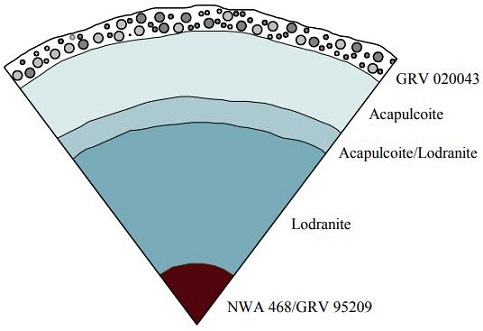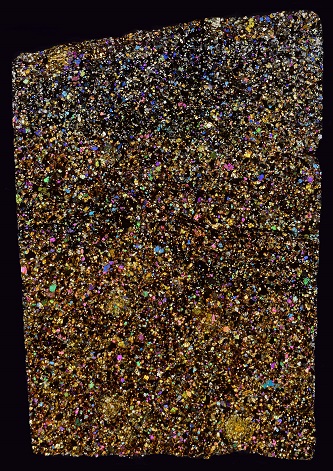Dho 125
AcapulcoitePrimitive achondrite that belongs to a small group named after the Acapulco meteorite that was observed to fall in Mexico in 1976. Acapulcoites are made mostly of fine-grained olivine (Fo3-14), orthopyroxene(En86-97), Ca-rich pyroxene (En51Wo44), plagioclase (An12-31), Ni-Fe metal, and troilite. They are transitional between primordial chondritic matter and more differentiated Click on Term to Read More
Acapulcoite–LodraniteRare type of primitive achondrite named after the Lodran meteorite that fell in Pakistan in 1868. Initially, lodranites were grouped with the stony-iron meteorites because they contain silicates (olivine, orthopyroxene, and minor plagioclase) and Fe-Ni metal in nearly equal proportions. However, since discovery of the closely related acapulcoite group, lodranites Click on Term to Read More Clan
Found January 26, 2000
18° 59.20′ N., 54° 36.03′ E. A single stone covered with black fusion crustMelted exterior of a meteorite that forms when it passes through Earth’s atmosphere. Friction with the air will raise a meteorite’s surface temperature upwards of 4800 K (8180 °F) and will melt (ablate) the surface minerals and flow backwards over the surface as shown in the Lafayette meteorite photograph below. Click on Term to Read More and weighing 2,697 g was found in the Dhofar region of Oman. Sometime later, the 354 g Dhofar 312 was recovered ~500 m away; analyses indicate they might be paired. Dhofar 125 is a highly equilibrated acapulcoite having a recrystallized texture with 120° triple junctions. Dhofar 125 is composed of low-Ca pyroxeneA class of silicate (SiO3) minerals that form a solid solution between iron and magnesium and can contain up to 50% calcium. Pyroxenes are important rock forming minerals and critical to understanding igneous processes. For more detailed information, please read the Pyroxene Group article found in the Meteoritics & Classification category. Click on Term to Read More (35.6 vol%), olivineGroup of silicate minerals, (Mg,Fe)2SiO4, with the compositional endpoints of forsterite (Mg2SiO4) and fayalite (Fe2SiO4). Olivine is commonly found in all chondrites within both the matrix and chondrules, achondrites including most primitive achondrites and some evolved achondrites, in pallasites as large yellow-green crystals (brown when terrestrialized), in the silicate portion Click on Term to Read More (27.5 vol%), plagioclaseAlso referred to as the plagioclase feldspar series. Plagioclase is a common rock-forming series of feldspar minerals containing a continuous solid solution of calcium and sodium: (Na1-x,Cax)(Alx+1,Si1-x)Si2O8 where x = 0 to 1. The Ca-rich end-member is called anorthite (pure anorthite has formula: CaAl2Si2O8) and the Na-rich end-member is albite Click on Term to Read More (14.0 vol%), troiliteBrass colored non-magnetic mineral of iron sulfide, FeS, found in a variety of meteorites. Click on Term to Read More (7.7 vol%), augiteHigh-Ca clinopyroxene, (Ca,Mg,Fe)SiO3, that occurs in many igneous rocks, particularly those of basaltic composition. In order to be considered augite, the clinopyroxene must contain 20 to 45 mol % of calcium (Wo20 - 45). An important and unique Martian meteorite is NWA 8159, that has been classified as an augite basalt. Click on Term to Read More (6.5 vol%), FeNi-metal (5.3 vol%), and minor chlorapatite and chromiteBrownish-black oxide of chromium and iron (Cr-Fe oxide), Cr2FeO4, found in many meteorite groups. Click on Term to Read More. While the oxygen-isotopic, compositional, and thermal equilibriumTerm used to describe physical or chemical stasis. Physical equilibrium may be divided into two types: static and dynamic. Static equilibrium occurs when the components of forces and torques acting in one direction are balanced by components of forces and torques acting in the opposite direction. A system in static Click on Term to Read More data are consistent with the other acapulcoitesPrimitive achondrite that belongs to a small group named after the Acapulco meteorite that was observed to fall in Mexico in 1976. Acapulcoites are made mostly of fine-grained olivine (Fo3-14), orthopyroxene(En86-97), Ca-rich pyroxene (En51Wo44), plagioclase (An12-31), Ni-Fe metal, and troilite. They are transitional between primordial chondritic matter and more differentiated Click on Term to Read More, the average grain size in Dhofar 125 is significantly smaller than that of other acapulcoites. Dhofar 125 has a shock stageA petrographic assessment, using features observed in minerals grains, of the degree to which a meteorite has undergone shock metamorphism. The highest stage observed in 25% of the indicator grains is used to determine the stage. Also called "shock level". Click on Term to Read More of S1 and a weathering grade that varies from W1 in the coreIn the context of planetary formation, the core is the central region of a large differentiated asteroid, planet or moon and made up of denser materials than the surrounding mantle and crust. For example, the cores of the Earth, the terrestrial planets and differentiated asteroids are rich in metallic iron-nickel. Click on Term to Read More to W2 near the rim.
The thermal history of the acapulcoites was explored in a study by El Goresy et al. (2005), in which they examined the diversity of isotopic compositions of graphiteOpaque form of carbon (C) found in some iron and ordinary chondrites and in ureilite meteorites. Each C atom is bonded to three others in a plane composed of fused hexagonal rings, just like those in aromatic hydrocarbons. The two known forms of graphite, α (hexagonal) and β (rhombohedral), have Click on Term to Read More in the Acapulco meteoriteWork in progress. A solid natural object reaching a planet’s surface from interplanetary space. Solid portion of a meteoroid that survives its fall to Earth, or some other body. Meteorites are classified as stony meteorites, iron meteorites, and stony-iron meteorites. These groups are further divided according to their mineralogy and Click on Term to Read More. They identified various accessory graphite morphologies having a number of distinctive C- and N-isotopic signatures, which indicated an origin from at least three pre-accretionary reservoirs. The form of graphite that contains the lightest N, which exists as exsolutionSegregation, during cooling, of a homogeneous solid solution into two or more different solids. Click on Term to Read More veneers between kamaciteMore common than taenite, both taenite and kamacite are Ni-Fe alloys found in iron meteorites. Kamacite, α-(Fe,Ni), contains 4-7.5 wt% Ni, and forms large body-centered cubic crystals that appear like broad bands or beam-like structures on the etched surface of a meteorite; its name is derived from the Greek word Click on Term to Read More and taeniteLess common than kamacite, both taenite and kamacite are Ni-Fe alloys found in iron meteorites. Taenite, γ-(Fe,Ni), has 27-65 wt% Ni, and forms small crystals that appear as highly reflecting thin ribbons on the etched surface of a meteorite; the name derives from the Greek word for "ribbon." Click on Term to Read More, is thought to preserve the most primordial C- and N-isotopic signatures from pre-accretionary FeNi-metal. In addition, they found rare graphite grains within metal–sulfide spherules with isotopic compositions similar to those of graphite grains in the matrixFine grained primary and silicate-rich material in chondrites that surrounds chondrules, refractory inclusions (like CAIs), breccia clasts and other constituents. Click on Term to Read More, while the spherules themselves have a spatial distribution within silicates suggesting a formation by partial meltingAn igneous process whereby rocks melt and the resulting magma is comprised of the remaining partially melted rock (sometimes called restite) and a liquid whose composition differs from the original rock. Partial melting occurs because nearly all rocks are made up of different minerals, each of which has a different melting Click on Term to Read More of matrix metalElement that readily forms cations and has metallic bonds; sometimes said to be similar to a cation in a cloud of electrons. The metals are one of the three groups of elements as distinguished by their ionization and bonding properties, along with the metalloids and nonmetals. A diagonal line drawn Click on Term to Read More. Furthermore, the occurrence of entrapped orthopyroxene–troilite symplectites with quench textures supports a history of partial melting and in situ recrystallization, perhaps without melt migration.
Hidaka et al. (2013) report a nearly chondritic composition for this and other acapulcoites with respect to the non-magnetic component. The chondritic Hf–W ratio is consistent with minimal migration of partial melts. The Hf–W isochron provides a well-defined age of 4.5631 (±0.0008) b.y., or ~6 m.y. after CAISub-millimeter to centimeter-sized amorphous objects found typically in carbonaceous chondrites and ranging in color from white to greyish white and even light pink. CAIs have occasionally been found in ordinary chondrites, such as the L3.00 chondrite, NWA 8276 (Sara Russell, 2016). CAIs are also known as refractory inclusions since they Click on Term to Read More formation. In a comparison with other chronometers, the Hf–W age was shown to be older, possibly reflecting the onset of thermal metamorphism rather than peak temperatures (Touboul et al., 2006). When the Hf–W chronometry is coupled with Pb–Pb data (4.5559 [±0.0006] b.y.), it indicates that cooling rates were more rapid than those of H6 chondritesChondrites are the most common meteorites accounting for ~84% of falls. Chondrites are comprised mostly of Fe- and Mg-bearing silicate minerals (found in both chondrules and fine grained matrix), reduced Fe/Ni metal (found in various states like large blebs, small grains and/or even chondrule rims), and various refractory inclusions (such Click on Term to Read More, but similar to those of H4 chondrites (Kleine et al., 2007). Considering their similar cooling rates and the significantly higher thermal metamorphism experienced by acapulcoites compared to H4 chondrites, an earlier commencement of accretionAccumulation of smaller objects into progressively larger bodies in the solar nebula leading to the eventual formation of asteroids, planetesimals and planets. The earliest accretion of the smallest particles was due to Van der Waals and electromagnetic forces. Further accretion continued by relatively low-velocity collisions of smaller bodies in the Click on Term to Read More and/or a smaller parent bodyThe body from which a meteorite or meteoroid was derived prior to its ejection. Some parent bodies were destroyed early in the formation of our Solar System, while others like the asteroid 4-Vesta and Mars are still observable today. Click on Term to Read More size for the acapulcoites is a reasonable inference. Another possibility for the early rapid cooling of the acapulcoite parent body may be that it experienced a collisional disruption early in its history forming sub-km- to multi-km-sized fragments, which eventually succumbed to gravitational reassembly.
Similar to E chondrites, Dhofar 125 contains an excess of radiogenic 129Xe, which is indicative of early incorporation of 129I into the rock (Patzer et al., 2003). It was suggested that this noble gasElement occurring in the right-most column of the periodic table; also called "inert" gases. In these gases, the outer electron shell is completely filled, making them very unreactive. Click on Term to Read More data and other mineralogical similarities between these meteorite groups indicated a genetic relationship exists. An I–Xe age of 4.5571 (±0.0005) b.y. was determined for Dhofar 125 (Schönbächler et al., 2014). The meteorite has a CRE age of 5.7 m.y, which is within the narrow range of virtually all of the acapulcoites (4–7 m.y.).
Based on siderophile elementLiterally, "iron-loving" element that tends to be concentrated in Fe-Ni metal rather than in silicate; these are Fe, Co, Ni, Mo, Re, Au, and PGE. These elements are relatively common in undifferentiated meteorites, and, in differentiated asteroids and planets, are found in the metal-rich cores and, consequently, extremely rare on abundances in magnetic components, and lithophile elementElement that tends to be concentrated in the silicate phase, e.g., B, O, halogens, alkali earths, alkali metals, Al, Si, Sc, Ti, V, Cr, Mn, Y, Zr, Nb, REE, Hf, Ta, W, Th, and U. abundances in non-magnetic components, Hidaka et al. (2012) concluded that the precursor material of the acapulcoite–lodranite clan was most similar to EL chondrites. Schrader et al. (2017) observed an absence of chromite grains in relict chondrulesRoughly spherical aggregate of coarse crystals formed from the rapid cooling and solidification of a melt at ~1400 ° C. Large numbers of chondrules are found in all chondrites except for the CI group of carbonaceous chondrites. Chondrules are typically 0.5-2 mm in diameter and are usually composed of olivine Click on Term to Read More from acapulcoite GRA 98028. They recognized that chromite grains are only present in type II chondrules, and that these occur in greatest abundance in ordinary chondrites but are less abundant in carbonaceous and enstatiteA mineral that is composed of Mg-rich pyroxene, MgSiO3. It is the magnesium endmember of the pyroxene silicate mineral series - enstatite (MgSiO3) to ferrosilite (FeSiO3). Click on Term to Read More chondrites. Based on this reasoning as well as other data, they consider it likely that the precursor of acapulcoites was similar to a carbonaceous chondriteCarbonaceous chondrites represent the most primitive rock samples of our solar system. This rare (less than 5% of all meteorite falls) class of meteorites are a time capsule from the earliest days in the formation of our solar system. They are divided into the following compositional groups that, other than Click on Term to Read More of a type unknown in our collections. On the other hand, Keil and McCoy (2017) consider an S-type asteroid to be the most likely parental source object. Regardless of the specific chemical composition of the precursor, acapulcoites and lodranites formed on a common parent body and share similar thermal histories.
Notably, the chondriteChondrites are the most common meteorites accounting for ~84% of falls. Chondrites are comprised mostly of Fe- and Mg-bearing silicate minerals (found in both chondrules and fine grained matrix), reduced Fe/Ni metal (found in various states like large blebs, small grains and/or even chondrule rims), and various refractory inclusions (such Click on Term to Read More Grove Mountains (GRV) 020043, initially classified as H4, is most similar to primitive achondrites of the acapulcoite–lodranite parent body based on both its mineralogy and with respect to its O-isotopic composition. It was proposed that this meteorite represents the chondritic precursor of the acapulcoite–lodranite parent body (Li et al., 2010; abstract. The differences that do exist, such as in the elements V, Cr, and Se, may be related to specific characteristics of the precursor phase (Hidaka et al., 2012). A comprehensive study of GRV 020043 and other related meteorites was subsequently conducted by Li et al. (2018), and they clearly demonstrated that the mineralogy, geochemistryStudy of the chemical composition of Earth and other planets, chemical processes and reactions that govern the composition of rocks and soils, and the cycles of matter and energy that transport Earth's chemical components in time and space. Click on Term to Read More, and O- and Cr-isotopic composition of this meteorite supports its reclassification as ‘Acapulcoite chondrite’, representing the chondritic, unmelted, outermost layer of the acapulcoite–lodranite parent body. They also provided similar evidence that NWA 468 derives from the ACA–LOD parent body, which, along with the metal-rich lodranite GRA 95209 (NASA lab photo), are considered to represent the deepest lithology (early core segregation) of the parent body. A schematic representation of the acapulcoite–lodranite parent body was presented by Li et al. (2018): Interior Structure of the Acapulcoite–Lodranite Parent Body

Schematic diagram credit: Li et al., GCA, vol. 242, p. 96 (2018)
‘Evidence for a Multilayered Internal Structure of the Chondritic Acapulcoite–Lodranite Parent Asteroid’
(https://doi.org/10.1016/j.gca.2018.09.004) For more complete and current formation scenarios of the acapulcoite–lodranite parent body, visit the Monument Draw and Lodran pages. The Dhofar 125 specimen shown above is a 0.95 g interior slice. The photo below is an excellent petrographic thin sectionThin slice or rock, usually 30 µm thick. Thin sections are used to study rocks with a petrographic microscope. micrograph of Dhofar 125, shown courtesy of Peter Marmet. 
click on image for a magnified view
Photo courtesy of Peter Marmet







